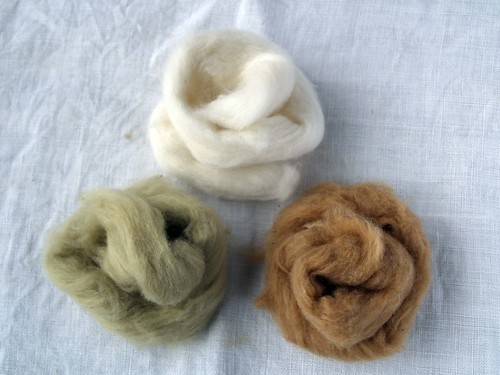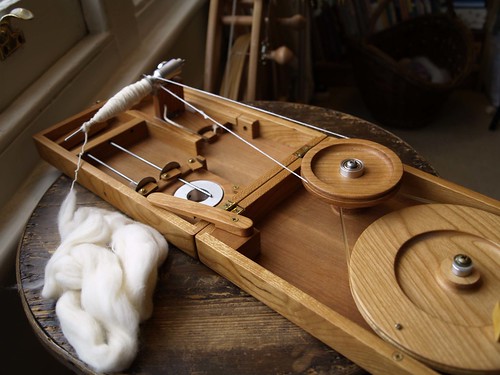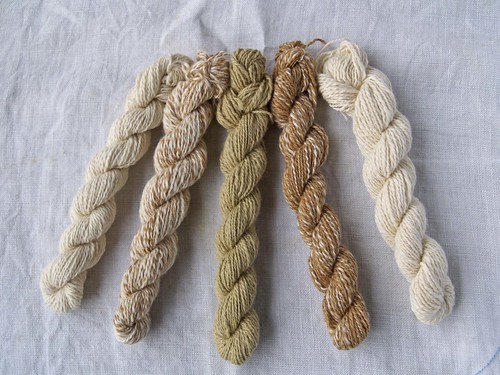Part Three: Cotton
Cotton has a long and fascinating history in the textile world and today still counts for by far the largest portion of the commercial natural fibre industry. It is a fibre which has often been at the centre of things; Cotton Bonds helped to fund the South in the American Civil War and the spinning of cotton was integral to Ghandi’s campaign to free India from English rule, re-igniting an industry over 3000 years old. Fragments of cotton textiles have been dated back to the stone age and it has been a popular fibre choice for clothing all over the world throughout history.
(Cotton flower, and naturally coloured cotton boll ready for picking, photos by Phreadde Davis)
Harvesting
Cotton is a perennial plant, but nowadays is usually grown commercially as an annual, with plants being resown each year. It grows best in hot, dry climates and some varieties can reach up to 6 feet tall. The flowers develop into pods in which the seeds are protected by a mass of fibres, up to 4000 on each seed. As the fibres grow, they coil and twist, when the plants mature the fibres straighten, causing the pods to burst open.
Cotton is picked commercially by machine, either stripping the seeds and fibres from the pods, or taking the whole boll. Seeds are removed by a process called ginning, and the cotton is carded or combed in preparation for spinning. Handspinners often spin cotton straight from the seed, saving on labour if the cotton is home-grown.
(Cotton seeds ready for spinning)
Structure and Characteristics
Cotton fibres grow layer upon layer of cellulose in hollow cylindrical tubes, when picked the tubes then collapse into flat ribbons. This tubular, layered structure is what gives cotton it’s excellent absorbant qualities. The many coils and twists in the fibres create a crimp and springiness rather like that of a fine wool, which makes cotton easier to spin than smoother fibres. Cotton is stronger than wool, but weaker than silk or linen. It burns easily and is very susceptible to damage from acids and mildew. Fibres will also weaken with prolonged exposure to sunlight.
Cotton fibres are generally in the range of 12-20 microns in diameter, and can vary in length from 0.5 to 2.5 inches. The fibres have good luster which can be greatly increased through the process of Mercerization which plumps and straightens the fibres creating a lovely surface sheen.
Varieties
There are many different varieties of cotton, found in tropical and subtropical climates all over the world. It is a member of the Gossypium or Mallow family (source of our word ‘marshmallow’) which also includes Hibiscus and Hollyhocks.
Egyptian cotton is popular for luxury cotton products, its particularly long smooth staple is softer and more durable than American (Pima) cotton. Other varieties include Sea Island, Peruvian, and Indian, but these account for very little of the commercial industry.
Many people are becoming concerned about the use of pesticides, insecticides and herbicides used in cotton growing (up to 25% of world use is for cotton crops) and are turning to organic varieties. Availability of organic fibres, yarns and finished garments is increasing rapidly with demand and it is now relatively easy to find organic alternatives. As part of this movement, we are seeing the reappearance of many beautiful naturally coloured cottons. A pioneer in this area, Sally Fox, has worked at researching and developing many varieties of natural coloured cottons in spite of resistance from the commercial white cotton industry.
(Organic cotton fibre in natural white, tan and green)
Cotton for Handspinners
Cotton is an extremely short fibre and is most successfully spun with a long draw or point-of-twist technique. A fine thread with lots of twist is normal, and thus a high ratio is needed. The traditional tool for spinning cotton, the Charkha, has an accelerated pulley system which allows for ratios of up to 100:1. Cotton can be successfully spun on a spinning wheel, however, with a high ratio and tension set to low, or a light drop or supported spindle.
(Book Charkha made by Jonothan Bosworth)
Cotton is often boiled after spinning to set the twist and remove any last traces of wax (this wax is generally removed in processing). Coloured cottons should be boiled as this process intensifies the colours, creating a much more striking effect.
(Skeins of Charkha-spun cotton)
With special thanks to Phreadde Davis who taught me to spin cotton, and provided the pictures of cotton plants for this article. Check out her blog at http://cottoncrop.blogspot.com/ and say hello from me!
Do you have questions? What are your experiences with cotton – like it? Love it? Leave a comment or come by the Lingr chatroom on Sunday evenings.
Sources/further reading
Ross, Mabel “Essentials of Yarn Design�?, 1983
Chadwick, Eileen “The Craft of Handspinning�?, Batsford Ltd, 1980.
MacKenzie McCuin, Judith ‘The Intentional Spinner’, Interweave press, 2009.
Albright, Barbara “The Natural Knitter�?, Potter Craft 2007
Wayland Barber, Elizabeth “Women’s Work – The First 20,000 Years�?, Norton, 1994.
BBC Television: “The Ascent of Money�? Episode 2, 2008.
Columbia Pictures: “Ghandi�?, 1982.
http://www.foxfibre.com/ Fox Fibre – Colour by Nature, Sally Fox’s website
http://www.spinningtheweb.org.uk ‘Spinning the Web – The Story of the Cotton Industry
http://en.wikipedia.org/wiki/Cotton Wikipedia - Cotton







 Entries (RSS)
Entries (RSS)
March 16th, 2009 at 8:29 pm
that’s fascinating- I’ve never seen a cotton plant before, which is funny because 30 years ago I worked in a textile factory (Coutaulds) which wove cotton into corduroy.
Spinning was done at another factory but the cops were brought to Durham , wound onto big cheese for the weaving shed , the corduroy was woven, but not cut and was transported to another mill which cut the top of the flat corduroy to get the furry surface .
I worked in the winding shed ( very boring) and then got promoted into quality control (a bit more interesting). Then I realised I was wasting my life and went to University!
March 16th, 2009 at 9:17 pm
I love reading your International Year of Natural Fibres posts!